Tag Archive: transition
July 1, 2020
by Carole Zangari -
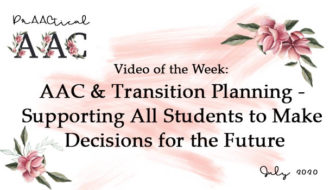
It is always a treat to learn from Erin Sheldon, and her recent presentation for the 2020 AAC in the Cloud conference is no exception. In this video, Erin helps think about effective ways that we can support the transition to post-school life for young people with significant communication challenges. You can obtain the handouts for this session here and learn more from Erin here. We’re deeply grateful to Erin for this wonderful session and to the amazing team at Cough Drop for another fantastic virtual conference. Direct Link to Video – https://www.youtube.com/watch?v=3Lwv9c3cotE&feature=emb_logo
Filed under: Video of the Week
Tagged With: emerging/beginning communicators, self-sdvocacy & self-determination, transition
April 22, 2020
by Carole Zangari -
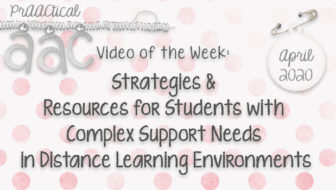
Because so many of you are fully engaged with online support of students with AAC needs right now, we’re featuring another video on that topic. Today, we learn about Strategies & Resources for Students with Complex Support Needs in Distance Learning Environments through an archived webinar sponsored by the National Technical Assistance Center on Transition and the Workforce Innovation Technical Assistance Center. In this video, you’ll learn more about supporting older students in this virtual environment.
Filed under: Video of the Week
Tagged With: online support, telepractice, transition
November 28, 2018
by Carole Zangari -
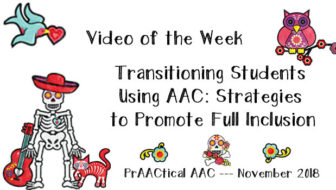
Transitions usually seem a bit daunting, but the move from the school system to post-school life is one fraught with a great many challenges. For people who use AAC, a group with unemployment rates exceeding 90%, the path to a rich and fulfilling life in adulthood requires a great deal of support. In many cases, the systems and individuals who are in the position to provide that support lack the information, experience, training, and resources they need to be effective. In today’s video, we hear from Dr. Rackensperger, Vice President for Persons who Use AAC and Their Families at USSAAC, who has a unique perspective on these issues. She shares ways that we can address these challenges by using person-based panning and strengths-based approaches in our efforts to foster self-determination and build self-advocacy. This video is part of the USSAAC webinar series and is made possible with the support of... [Read More...]
Filed under: Video of the Week
Tagged With: adulthood, post-school, self-advocacy, self-determination, transition
September 3, 2018
by Carole Zangari -
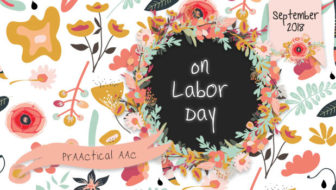
Here in the US, we are celebrating Labor Day and that gives us the opportunity to reflect on all things work-related. Join us as revisit some posts about AAC and the world of work. Enjoy! Transitioning to the Workplace: Resources for AAC Learners with Significant Disabilities Building an Awareness of AAC in Your Workplace Starting AAC with Teens and Adults Employment is for Everyone Learning About ACES
Filed under: Featured Posts, PrAACtical Thinking
Tagged With: employment, Labor Day, transition, work
March 15, 2018
by Carole Zangari -
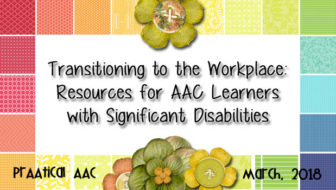
If we do our jobs well, students with AAC needs will leave school with a solid plan for post-secondary learning and/or the workplace. In most places, it can be challenging to identify meaningful work and learning experiences for young adults with AAC needs as they exit public education. While employment and educational opportunities for these young adults are slowly increasing, it is nonetheless a struggle to help young adults get prepared for their post-school lives. In this post, we share some resources that can help teams guide students and their families. QuickBook Of Transition Assessments (Cline, Halverson, Petersen, & Rohrbach, 2005) Reading-Free Vocational Interest Inventory–Second Edition (R-FVII:2) (Becker, 2000) Choose and Take Action Vocational Assessment Software (Martin, Marshall, Wray, Wells, O’Brien, Olvey, & Johnson, 2004) Self-Directed Employment: A Handbook for Transition Teachers and Employment Specialists, (Martin, Mithaug, Oliphint, Husch, & Frazier, 2002): May be out of print but available in... [Read More...]
Filed under: Featured Posts, PrAACtical Thinking
Tagged With: transition, vocational planniing, work
January 8, 2018
by Carole Zangari -
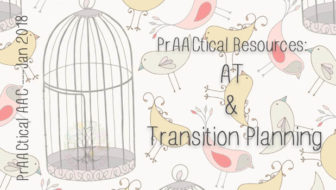
Moving from early intervention to preschool is a big step. Going from elementary school to middle school can be intimidating. Entering post-school life can be scary and overwhelming. Transitions require planning and coordination, but when the individual uses some form of AT there is an even greater need for organization and forethought. In today’s post, we share a guidebook developed by The Family Center on Technology and Disability with helpful information that will benefit families and service providers alike. Enjoy!
Filed under: Featured Posts, PrAACtical Thinking
Tagged With: school, transition
October 20, 2013
by Carole Zangari -

How can we address the needs of AAC learners as they grow and change? In this video, Karen Sheehan discusses iPad apps that can help students who with communication, organization, note taking, and reading. Thanks to the Accessible Technology Coalition for making this available.
Filed under: Video of the Week
Tagged With: education, note taking, transition
April 21, 2013
by Robin Parker -

We are loving all of the programs that WORK! We love the use of low & high tech supports that facilitate independence. What do you love?
Filed under: Video of the Week
Tagged With: ASD, iPad, transition, visual supports, work
July 7, 2012
by Carole Zangari -
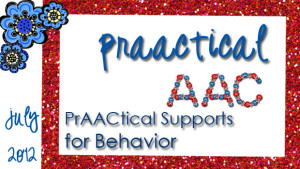
Rachel arrives to therapy tense and upset. Mauro gets frustrated when the clinician presents new activities. Brianna starts to bang the table when demands are placed on her. Zach becomes agitated when he has to wait for something he wants. – Like any set of tools and strategies, AAC works best when the communicator is relaxed, confident, and engaged. Our July Strategy of the Month focuses on PrAACtical Supports for Behavior. We hope to share ideas for planning therapy sessions that help AAC learners stay focused, calm, and engaged. — We’re big believers in the old adage that an ounce of prevention is worth a pound of cure. So, what can we do to prevent or minimize problems like the ones experienced by Rachel, Mauro, Brianna, and Zach? The answers have to do with having clear and appropriate expectations, and using visual and AAC supports effectively. When used consistently, these strategies... [Read More...]
Filed under: Strategy of the Month
Tagged With: aided language input, ASD, behavior, countdown board, developmental disability, first then, intervention, picture schedule, positive behavior support, transition, visual supports








